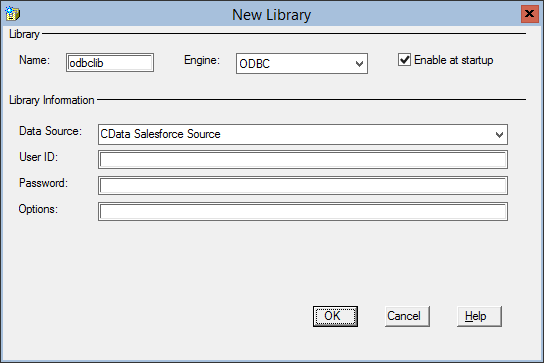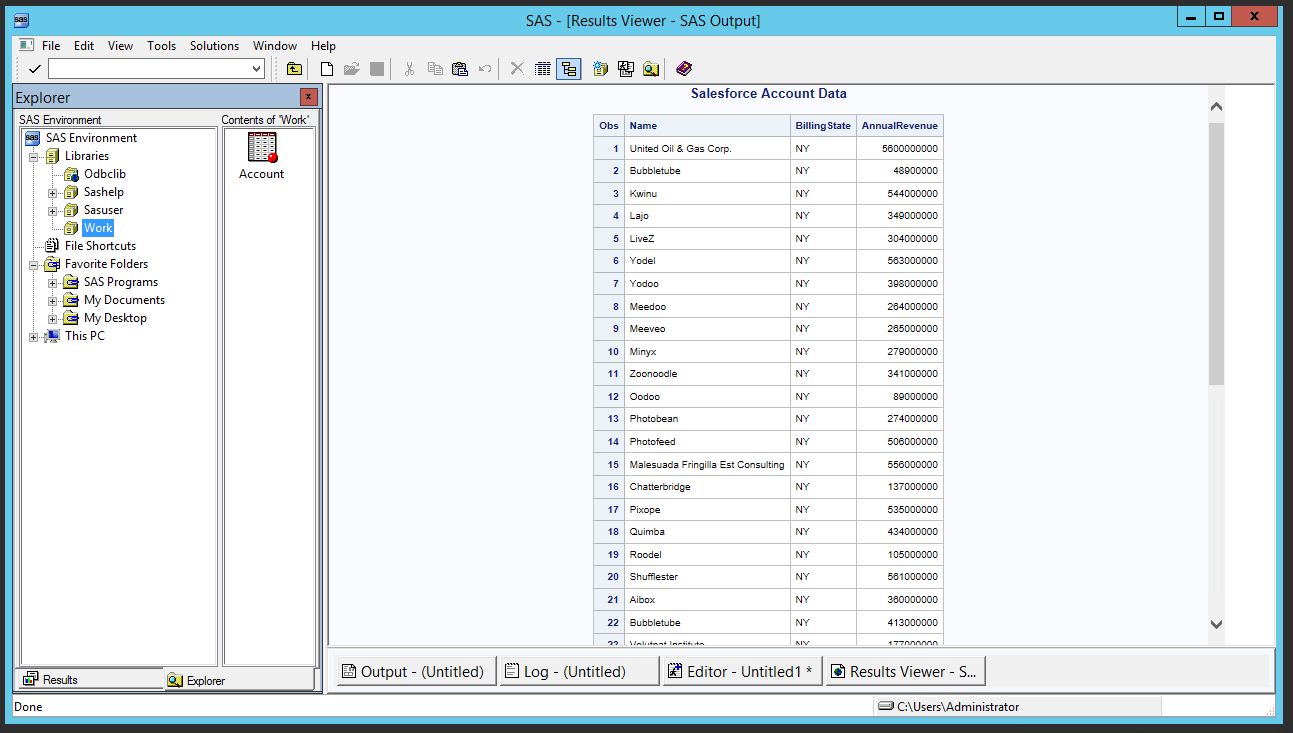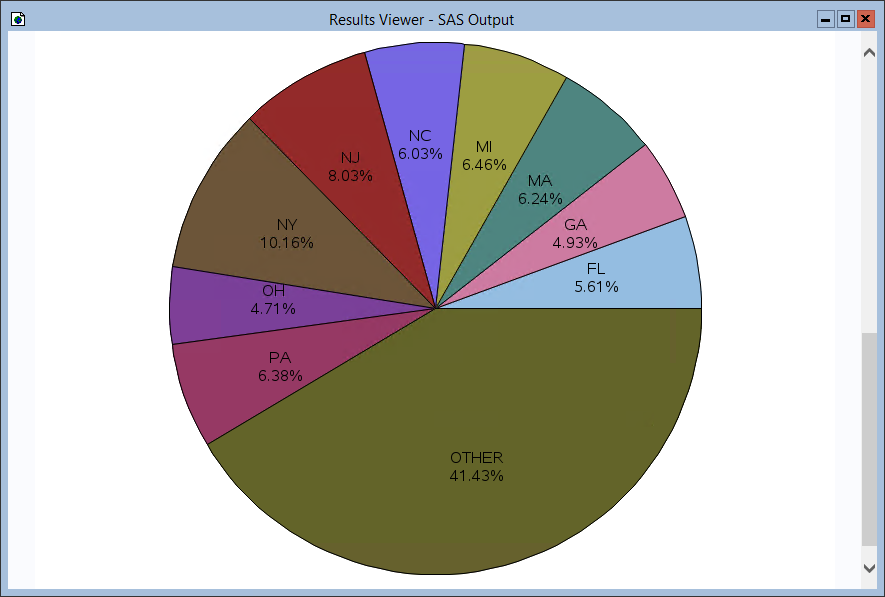Discover how a bimodal integration strategy can address the major data management challenges facing your organization today.
Get the Report →Use the CData ODBC Driver for HubDB in SAS for Real-Time Reporting and Analytics
Connect to real-time HubDB data in SAS for reporting, analytics, and visualizations using the CData ODBC Driver for HubDB.
SAS is a software suite developed for advanced analytics, multivariate analysis, business intelligence, data management, and predictive analytics. When you pair SAS with the CData ODBC Driver for HubDB, you gain database-like access to live HubDB data from SAS, expanding your reporting and analytics capabilities. This articles walks through creating a library for HubDB in SAS and creating a simple report based on real-time HubDB data.
The CData ODBC Driver offers unmatched performance for interacting with live HubDB data in SAS due to optimized data processing built into the driver. When you issue complex SQL queries from SAS to HubDB, the driver pushes supported SQL operations, like filters and aggregations, directly to HubDB and utilizes the embedded SQL engine to process unsupported operations (often SQL functions and JOIN operations) client-side. With built-in dynamic metadata querying, you can easily visualize and analyze HubDB data in SAS.
Connect to HubDB as an ODBC Data Source
Information for connecting to HubDB follows, along with different instructions for configuring a DSN in Windows and Linux environments (the ODBC Driver for HubDB must be installed on the machine hosting the SAS System).
There are two authentication methods available for connecting to HubDB data source: OAuth Authentication with a public HubSpot application and authentication with a Private application token.
Using a Custom OAuth App
AuthScheme must be set to "OAuth" in all OAuth flows. Be sure to review the Help documentation for the required connection properties for you specific authentication needs (desktop applications, web applications, and headless machines).
Follow the steps below to register an application and obtain the OAuth client credentials:
- Log into your HubSpot app developer account.
- Note that it must be an app developer account. Standard HubSpot accounts cannot create public apps.
- On the developer account home page, click the Apps tab.
- Click Create app.
- On the App info tab, enter and optionally modify values that are displayed to users when they connect. These values include the public application name, application logo, and a description of the application.
- On the Auth tab, supply a callback URL in the "Redirect URLs" box.
- If you're creating a desktop application, set this to a locally accessible URL like http://localhost:33333.
- If you are creating a Web application, set this to a trusted URL where you want users to be redirected to when they authorize your application.
- Click Create App. HubSpot then generates the application, along with its associated credentials.
- On the Auth tab, note the Client ID and Client secret. You will use these later to configure the driver.
Under Scopes, select any scopes you need for your application's intended functionality.
A minimum of the following scopes is required to access tables:
- hubdb
- oauth
- crm.objects.owners.read
- Click Save changes.
- Install the application into a production portal with access to the features that are required by the integration.
- Under "Install URL (OAuth)", click Copy full URL to copy the installation URL for your application.
- Navigate to the copied link in your browser. Select a standard account in which to install the application.
- Click Connect app. You can close the resulting tab.
Using a Private App
To connect using a HubSpot private application token, set the AuthScheme property to "PrivateApp."
You can generate a private application token by following the steps below:
- In your HubDB account, click the settings icon (the gear) in the main navigation bar.
- In the left sidebar menu, navigate to Integrations > Private Apps.
- Click Create private app.
- On the Basic Info tab, configure the details of your application (name, logo, and description).
- On the Scopes tab, select Read or Write for each scope you want your private application to be able to access.
- A minimum of hubdb and crm.objects.owners.read is required to access tables.
- After you are done configuring your application, click Create app in the top right.
- Review the info about your application's access token, click Continue creating, and then Show token.
- Click Copy to copy the private application token.
To connect, set PrivateAppToken to the private application token you retrieved.
When you configure the DSN, you may also want to set the Max Rows connection property. This will limit the number of rows returned, which is especially helpful for improving performance when designing reports and visualizations.
Windows
If you have not already, first specify connection properties in an ODBC DSN (data source name). This is the last step of the driver installation. You can use the Microsoft ODBC Data Source Administrator to create and configure ODBC DSNs.
Linux
If you are installing the CData ODBC Driver for HubDB in a Linux environment, the driver installation predefines a system DSN. You can modify the DSN by editing the system data sources file (/etc/odbc.ini) and defining the required connection properties.
/etc/odbc.ini
[CData HubDB Sys]
Driver = CData ODBC Driver for HubDB
Description = My Description
AuthScheme = OAuth
OAuthClientID = MyOAuthClientID
OAuthClientSecret = MyOAuthClientSecret
CallbackURL = http://localhost:33333
For specific information on using these configuration files, please refer to the help documentation (installed and found online).
Create a HubDB Library in SAS
Connect to HubDB in SAS by adding a library based on the CData ODBC Driver for HubDB.
- Open SAS and expand Libraries in the Explorer pane.
- In the Active Libraries window, right-click and select New.
- Name your library (odbclib), select ODBC as the Engine, and click to Enable at startup (if you want the library to persist between sessions).
- Set Data Source to the DSN you previously configured and click OK.
![Creating a library for HubDB in SAS.]()
Create a View from a HubDB Query
SAS natively supports querying data either using a low-code, point-and-click Query tool or programmatically with PROC SQL and a custom SQL query. When you create a View in SAS, the defining query is executed each time the view is queried. This means that you always query live HubDB data for reports, charts, and analytics.
Using the Query Tool
- In SAS, click Tools -> Query
- Select the table sources and the table(s) you wish to pull data from. Then, click OK.
![Selecting table(s) to visualize.]()
- Select columns and right-click to add filtering, ordering, grouping, etc.
![Selecting columns(s) to visualize and configuring the query.]()
- Create a local view to contain the query results by right-clicking the SQL Query Tool window, selecting Show Query, and clicking Create View. Name the View and click OK.
![Create a local view to work with HubDB data.]()
Using PROC SQL
- In SAS, navigate to the Editor window.
- Use PROC SQL to query the data and create a local view.
NOTE: This procedure creates a view in the Work library. You can optionally specify a library in the create view statement.proc sql; create view northwindproducts_view as select partitionkey, name from odbclib.northwindproducts where Id = '1'; quit; - Click Run -> Submit to execute the query and create a local view.
Report On or Visualize HubDB Data in SAS
With a local view created, you can report, visualize, or otherwise analyze HubDB data using the powerful SAS features. Print a simple report using PROC PRINT and create a basic graph based on the data using PROC GCHART.
Print an HTML Report
- In SAS, navigate to the Editor window.
- Use PROC PRINT to print an HTML report for the HubDB NorthwindProducts data.
proc print data=northwindproducts; title "HubDB NorthwindProducts Data"; run;
![A simple HubDB data report.]()
Print a Chart
- In SAS, navigate to the Editor window.
- Use PROC GCHART to create a chart for the NorthwindProducts data.
proc gchart data=northwindproducts; pie partitionkey / sumvar=name value=arrow percent=arrow noheading percent=inside plabel=(height=12pt) slice=inside value=none name='NorthwindProductsChart'; run;![A simple HubDB data chart.]()











